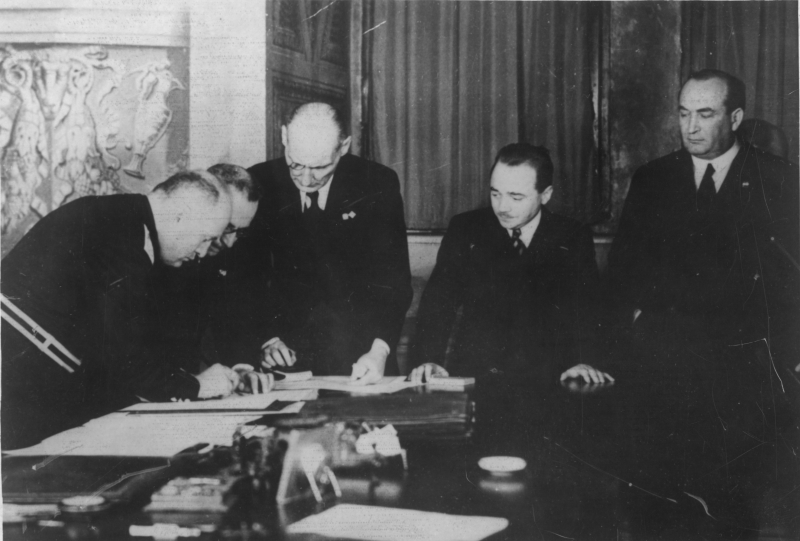Rome Protocols on:
[Wikipedia]
[Google]
[Amazon]
 The Rome Protocols were a series of three international agreements concluded in
The Rome Protocols were a series of three international agreements concluded in
Text of Protocol No. 1
Treaties concluded in 1934 Interwar-period treaties Treaties of the Kingdom of Italy (1861–1946) Treaties of the Kingdom of Hungary (1920–1946) Treaties of the First Austrian Republic 1934 in Italy Austria–Hungary relations Austria–Italy relations Hungary–Italy relations
 The Rome Protocols were a series of three international agreements concluded in
The Rome Protocols were a series of three international agreements concluded in Rome
, established_title = Founded
, established_date = 753 BC
, founder = King Romulus (legendary)
, image_map = Map of comune of Rome (metropolitan city of Capital Rome, region Lazio, Italy).svg
, map_caption ...
on 17 March 1934 between the governments of Austria
Austria, , bar, Östareich officially the Republic of Austria, is a country in the southern part of Central Europe, lying in the Eastern Alps. It is a federation of nine states, one of which is the capital, Vienna, the most populous ...
, Hungary
Hungary ( hu, Magyarország ) is a landlocked country in Central Europe. Spanning of the Pannonian Basin, Carpathian Basin, it is bordered by Slovakia to the north, Ukraine to the northeast, Romania to the east and southeast, Serbia to the ...
and Italy
Italy ( it, Italia ), officially the Italian Republic, ) or the Republic of Italy, is a country in Southern Europe. It is located in the middle of the Mediterranean Sea, and its territory largely coincides with the homonymous geographical ...
. They were signed by Italian Prime Minister Benito Mussolini, Austrian Chancellor Engelbert Dollfuss
Engelbert Dollfuß (alternatively: ''Dolfuss'', ; 4 October 1892 – 25 July 1934) was an Austrian clerical fascist politician who served as Chancellor of Austria between 1932 and 1934. Having served as Minister for Forests and Agriculture, he ...
and Hungarian Prime Minister Gyula Gömbös. All of the protocols went into effect on 12 July 1934 and were registered in ''League of Nations Treaty Series'' on 12 December 1934.''League of Nations Treaty Series'', vol. 154, pp. 282-303.
Background
The Rome Protocols, even though they dealt only with economic development, were part of the process of co-operation between the three signatory governments against the revisionist policies ofAdolf Hitler
Adolf Hitler (; 20 April 188930 April 1945) was an Austrian-born German politician who was dictator of Nazi Germany, Germany from 1933 until Death of Adolf Hitler, his death in 1945. Adolf Hitler's rise to power, He rose to power as the le ...
, who had just come to power in Germany, as well as against the territorial integrity of Yugoslavia
Yugoslavia (; sh-Latn-Cyrl, separator=" / ", Jugoslavija, Југославија ; sl, Jugoslavija ; mk, Југославија ;; rup, Iugoslavia; hu, Jugoszlávia; rue, label=Pannonian Rusyn, Югославия, translit=Juhoslavija ...
, which they wished to dismember among themselves. The protocols' co-operation was short-lived since in 1938, Mussolini allowed Hitler to invade Austria, and the Hungarian government, led by Miklós Horthy
Miklós Horthy de Nagybánya ( hu, Vitéz nagybányai Horthy Miklós; ; English: Nicholas Horthy; german: Nikolaus Horthy Ritter von Nagybánya; 18 June 1868 – 9 February 1957), was a Hungarian admiral and dictator who served as the regent ...
, also supported the Third Reich
Nazi Germany (lit. "National Socialist State"), ' (lit. "Nazi State") for short; also ' (lit. "National Socialist Germany") (officially known as the German Reich from 1933 until 1943, and the Greater German Reich from 1943 to 1945) was ...
that year.
Terms
Protocol No 1 was very brief and contained no clauses but only a brief statement in which the signatories undertook "To confer together on all problems which particularly concern them, and on problems of a general character, with a view to pursuing, in the spirit of the existing treaties of friendship between Italy and Austria, Italy and Hungary and Austria and Hungary, which are based on a recognition of the existence of numerous common interests, a concordant policy directed towards the promotion of effective co-operation between the States of Europe and particularly between Italy, Austria and Hungary". In the following paragraph, the three governments undertook "to hold joint consultations whenever at least one of them deems it desirable". Protocol No 2 dealt with economic relations between the three governments. In Article 1 the three governments undertook not to place any obstacles to trade between them and to conclude commercial treaties to that effect. In Article 2, the parties undertook to assist the Hungarian government because of the fall in the price of wheat. In Article 3, the parties undertook to facilitate the rapid transit of goods through the ports of theAdriatic Sea
The Adriatic Sea () is a body of water separating the Italian Peninsula from the Balkan Peninsula. The Adriatic is the northernmost arm of the Mediterranean Sea, extending from the Strait of Otranto (where it connects to the Ionian Sea) to t ...
. In Article 4, the parties undertook to establish a commission of experts to make further recommendations in the economic field.
Protocol No 3 was concluded between only the governments of Italy and Austria. In Article 1, both governments undertook to negotiate a new trade treaty between them as soon as possible. In Article 2, they undertook to grant each other trade privileges in the new trade treaty to be negotiated.
Notes
{{ReflistExternal links
Text of Protocol No. 1
Treaties concluded in 1934 Interwar-period treaties Treaties of the Kingdom of Italy (1861–1946) Treaties of the Kingdom of Hungary (1920–1946) Treaties of the First Austrian Republic 1934 in Italy Austria–Hungary relations Austria–Italy relations Hungary–Italy relations